VHDL
-

The Power of VHDL’s VHPI
The programming interfaces of logic simulators are largely the domain of specialists writing proprietary tools and extensions and are only vaguely in the consciousness of many design and verification engineers, if aware at all. Yet the simplest use of such interfaces opens up a whole world of possibilities in extending what is achievable in verifying… The Power of VHDL’s VHPI
-
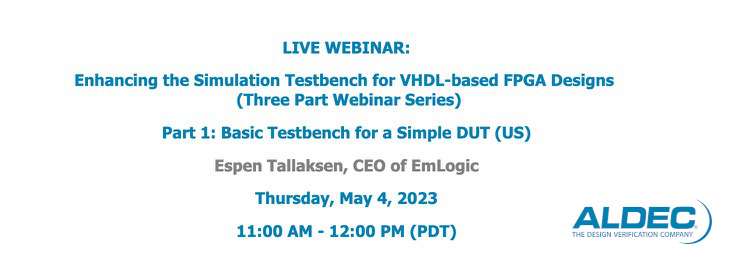
Basic Testbench for a Simple DUT
Presenter: Espen Tallaksen, CEO of EmLogic Abstract Part 1: Functional simulation using an HDL testbench is the de facto method for proving functional correctness of FPGA designs. In this three-part webinar series we will present a step-by-step approach on how to architect a testbench - progressing from basic to advanced techniques. We will first use… Basic Testbench for a Simple DUT
-
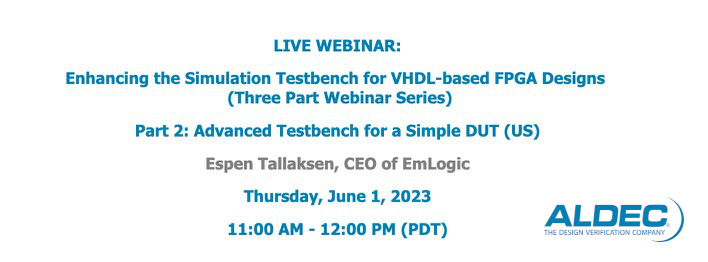
Advanced Testbench for a Simple DUT
Abstract: Functional simulation using an HDL testbench is the de facto method for proving functional correctness of FPGA designs. In this three-part webinar series, we will present a step-by-step approach on how to architect a testbench - progressing from basic to advanced techniques. We will first use a simple DUT then go to a more… Advanced Testbench for a Simple DUT
-
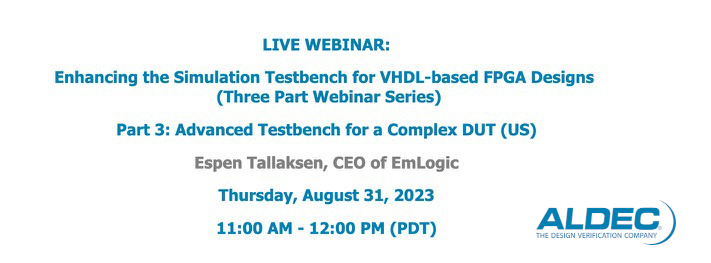
Advanced Testbench for a Complex DUT
Abstract: Functional simulation using an HDL testbench is the de facto method for proving functional correctness of FPGA designs. In this three-part webinar series, we will present a step-by-step approach on how to architect a testbench – progressing from basic to advanced techniques. We will first use a simple DUT then go to a more… Advanced Testbench for a Complex DUT
-

Advanced Testbench for a Complex DUT
Functional simulation using an HDL testbench is the de facto method for proving functional correctness of FPGA designs. In this three-part webinar series, we will present a step-by-step approach on how to architect a testbench – progressing from basic to advanced techniques. We will first use a simple DUT then go to a more complex… Advanced Testbench for a Complex DUT
-
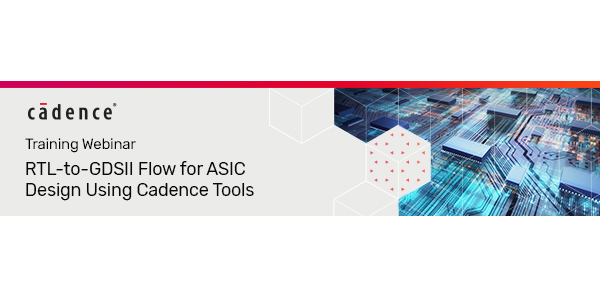
RTL-to-GDSII Flow for ASIC Design Using Cadence Tools
Would you like to know how to design a complete chip using the RTL-to-GDSII Flow? In this free technical Training Webinar with Application Engineer Sai Srinivas Pamula, we’ll teach you the essential steps in the RTL-to-GDSII design flow using a wide variety of industry-leading Cadence tools—such as the Xcelium Logic Simulator, Modus DFT Software Solution,… RTL-to-GDSII Flow for ASIC Design Using Cadence Tools
-
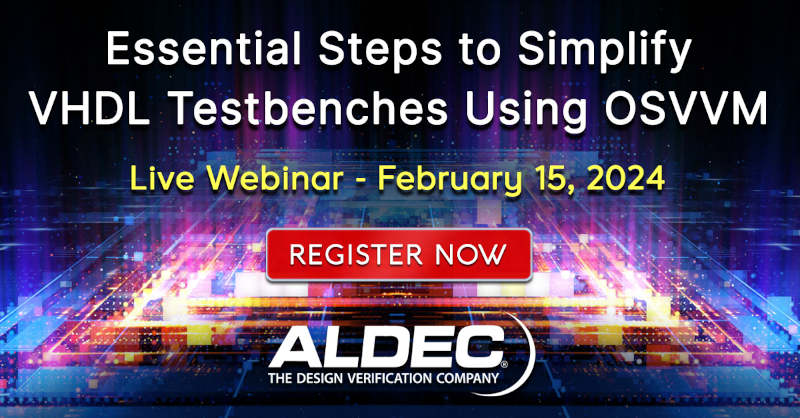
Essential Steps to Simplify VHDL Testbenches Using OSVVM
This “Getting Started” webinar focuses on the first, essential steps you need to take when looking to improve your VHDL testbench approach. In this webinar we examine transaction-based testing, self-checking tests, messaging, reports, and Open Source VHDL Verification Methodology (OSVVM) helper utilities. The “transaction” in transaction-based testing is just a fancy word for an… Essential Steps to Simplify VHDL Testbenches Using OSVVM
-

DVClub Europe: Latest VHDL Verification Techniques
This DVClub focuses on the latest verification techniques in VHDL including UVVM and OSVVM Agenda (GMT) 13:00 Welcome and Introduction – Mike Bartley, Tessolve 13:00 Epsen Tallaksen, EmLogic - Get the right FPGA quality through efficient Specification Coverage (aka Requirement Coverage) 13:30 Jim Lewis, SynthWorks - OSVVM in a NutShell, VHDL’s #1 Verification Methodology 14:00 Close Additional… DVClub Europe: Latest VHDL Verification Techniques
-
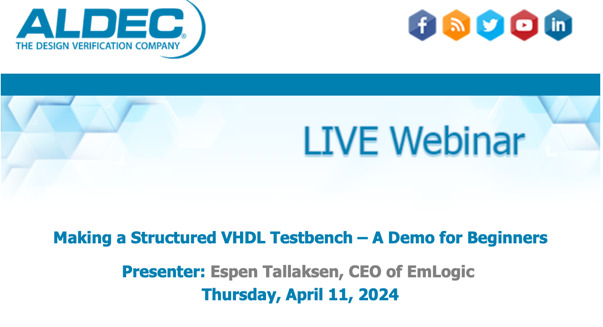
Making a Structured VHDL Testbench – A Demo for Beginners
Abstract: This demonstrated tutorial is intended for designers and verification engineers who want to learn to make better and more structured testbenches. This session will show you what is needed for any good testbench, irrespective of its complexity. We will make a testbench from scratch for a simple VHDL module and do the following: Add… Making a Structured VHDL Testbench – A Demo for Beginners
-

Why Should Our Team be Using VHDL + OSVVM for Verification?
Abstract: This is a high-level presentation that identifies the key aspects of a modern verification methodology and shows how to achieve them with OSVVM. This is a great presentation to share with your management about why OSVVM (and OSVVM training) is important for your team. Description: Developing and deploying a verification methodology can be costly… Why Should Our Team be Using VHDL + OSVVM for Verification?
-

Using OSVVM’s AXI4 Verification Components: Pt 1 Creating the AXI4 Testbench / Test Harness
European Session Abstract: This “Getting Started” presentation is for engineers who need to use the OSVVM AXI4 verification components (VCs) in their testbenches. Part 1 of this presentation provides a detailed walkthrough of creating a testbench environment that uses AXI4 VCs. AXI4 VCs are probably the most complex VCs in the OSVVM library. This complexity… Using OSVVM’s AXI4 Verification Components: Pt 1 Creating the AXI4 Testbench / Test Harness
-

Using OSVVM’s AXI4 Verification Components
Abstract: This “Getting Started” presentation is for engineers who need to use the OSVVM AXI4 verification components (VCs) in their testbenches. Part 2 of this presentation focuses on how to write tests and configure the AXI4 VCs. AXI4 VCs are probably the most complex VCs in the OSVVM library. This complexity is due to the… Using OSVVM’s AXI4 Verification Components